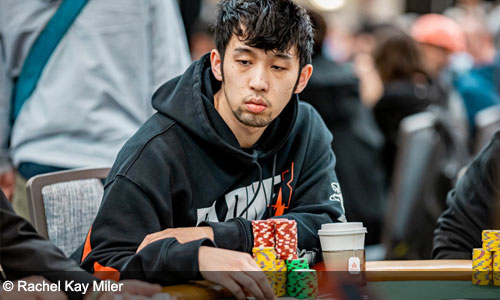All-In Poker: When To Shove and When to Avoid It?

Sure, that’s something that happens now and then, but there are other various situations that we need to take into account when we want to make all-in bets.
First of all, let’s define what an all-in bet is.
What Is an All-In Bet?
When a player makes an all-in bet, they essentially bet all chips they currently have. All-ins are sometimes used when players are short-stacked and need to make a final attempt of winning some chips back. However, “shoving” all chips to the middle of the table is also a strategic device used by poker players to bluff and confuse opponents. In other words, an all-in bet is a pretty powerful strategy if you know how and when to use it.
In this article, we are going to take a look at a couple of tips that can help us decide when to use and when to avoid this type of bet.
Rules of All-in Bets
There are a couple of essential rules you need to take into account that are related to shoving. Two situations are essential for this type of play — when there are only two players left and when there are more than two players. Let’s examine each of these.
1. One-On-One All-In Betting Rules
When there are only two players left in the game, all-in betting rules are pretty straightforward. If you have $50, your opponent has $100 and you decide to go all-in, your opponent will have to follow. Except that it’s you who puts your entire participation in the game at stake, whereas your opponent bets only half of his entire stack.
In case you lose, you will have to leave the game or buy more chips if you’re playing a cash game. On the other hand, if you win, you will receive an additional $50 and “double-up,” but your opponent will still be in the game with $50 remaining in his stack.
2. Betting Rules for More Than Two Players — Introducing Side Pots
Side pots are pretty self-explanatory — they are made after there’s no more room in the main pot. These are usually created when a player goes all-in and other players continue the betting round.
Let’s say that Mark, Stephen and John are three friends playing poker, and each one of them has a different chip size.
- Mark — $25
- Stephen — $100
- John — $200
Now, let’s say that Mark has some really good cards in his hand and decides to go all-in on the pre-flop betting round (he’s not that good in playing poker, obviously). If Stephen and John decide to call his actions, they will also have to bet $25 each.
Now that there are other betting rounds in a hand (the flop, the turn, and the river), Stephen and John want to continue betting and Mark doesn’t have enough funds to follow them. That’s why Stephen and John need to make another pot which is in no way related to the main pot.
Once the cards are revealed and it turns out that Mark still has the best cards, he will win a total of $75 which is in the main pot ($25 from each player). On the other hand, the side pot is distributed to the second-best player (let’s say that it’s Stephen). Simply put, Mark didn’t have access to the side pot, as he didn’t have enough chips to compete, that’s why the side pot was created in the first place.
Tips & Tricks for Utilising a Successful All-in Bet

Once again, it’s not only a powerful move but also a manipulative technique that can be very useful if you use it right. Read on!
Conscious Poker by Alec Torelli
# Pay Attention to Pot Odds
Poker is, above all, “a game of skill“, meaning that you can dumb it down to statistics if you want. You have to be a great mathematician if you want to hold things under control, but that sometimes takes all the fun out of poker.
Nevertheless, if you are one of those people who like to do their maths before they take action, you need to pay attention to pot odds. In other words, consider the statistical probability of your winning the hand and how many possible “outs” are there. If the numbers are in your favour, you can then decide whether you should shove or not. Naturally, this is not the only factor that should affect your decision, but it should definitely not be neglected.
# Know Thy Opponents
One of the biggest advantages of playing an all-in right is that you know your opponents. If they are somebody you have been playing poker for a long time (friends or family members), then you probably don’t even need to be a pro in order to read their faces and know how they are going to act.
On the other hand, if you meet these people for the first time, you need to be good at reading their faces, and you should pay attention to their previous actions. How did they react in a similar situation in one of the previous hands? When they think for too long, are they usually bluffing or not? How often do they bluff?
This is something that goes both ways. In other words, it doesn’t matter whether it’s you or them who made the first all-in bet, you need to decide what’s the best thing to do at that moment by analysing your opponents.
# Pay Attention to Stack Sizes
Your stack size, as well as stack sizes of your opponents, are very important when it comes to the all-in game. Naturally, if someone has a deep stack and goes all-in, the chances that they are going for a bluff are relatively higher than when they are short-stacked.
However, if you really want to take your all-in betting game to another level, you need to pay attention to stack-to-pot ratios, effective stacks, and how they can influence all-in bets.
# Analyse Your Previous Action
Poker is a game that requires a certain level of introspection. Poker players tend to unconsciously create patterns of behaviour that some opponents can notice and use it to gain an advantage. That’s why it’s very important to understand your patterns and, if possible, break them.
Sometimes, it’s not even about patterns, but about the way you hold your hands or move your head when you want to do something in poker. Imagine that you have great cards, and you want to snap-call your opponent, anxiously waiting for them to make a move that you would like them to make. Now, you might be twitching your leg, or simply holding your hand over the chips in a certain way. This is all individual, and it is particularly important when it comes to all-ins, as they usually spark the strongest emotions.
# Pay Attention to the Type of Contest
Cash games and tournaments are sometimes different when it comes to all-in bets. Most cash games will allow you to buy more chips and get back into the game, whereas players who go all-in and drop out usually don’t have an opportunity to take part in the competition anymore (unless re-entries are allowed).
Conclusion
These were some basic tips on how to approach all-in bets. In the end, you need to understand that poker also includes a bit of luck, meaning that no tricks are 100% successful. What you can do in order to improve your all-in game is to take this article into account when you play poker next time on any of our legal poker sites.
Also, make sure to do more in-depth research about all-ins, as there are numerous ways to use this simple bet in your favour, and some of them require a greater understanding of poker concepts.
Hi, I am the Chief Editor of top10pokersites.net, this site is dedicated to all thing poker. I have been working around the poker industry for the last 15 years, with different brands. The main purpose of this site is to keep you uptodate with the industry and offer you the best deals around.










